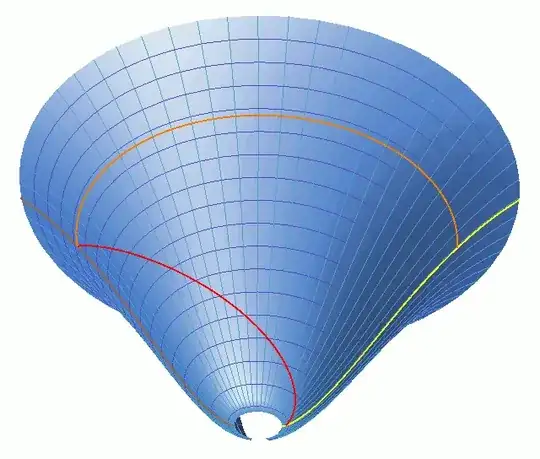Does the age of the universe depend upon a specific choice of referential or is there a way to define it in a referential-independent way?
-
A photon that shot out of the big bang, or if you happened to get caught in a black hole just at the big bang, then you would still see the universe as 0 years old, wouldn't you? – foolishmuse Apr 13 '21 at 22:09
-
Related, possible duplicate: https://physics.stackexchange.com/q/104153/123208 – PM 2Ring Apr 14 '21 at 06:57
-
@foolishmuse Why are you asking the OP that question? But anyway, a photon has no rest frame, as discussed in numerous answers on this site. OTOH, there's the Cosmic Neutrino Background, and their proper time is certainly less than the age of the universe measured in the CMB comoving frame. – PM 2Ring Apr 14 '21 at 08:31
-
See also https://physics.stackexchange.com/questions/516661/if-there-is-no-absolute-time-how-can-we-say-the-big-bang-was-13-8-billion-years – mlk Apr 14 '21 at 12:02
-
These are great answers, I would just like to add that the so called cosmological time is the time measured by a comoving clock, a clock which sees the universe isotropic or in other words which is in rest relativ to the microwave background. Since the very beginning such a clock measures the maximum age of the universe. Clocks which aren't comoving would measure a lower age and particles with relativistic speed like neutrinos a much lower age. – timm Apr 14 '21 at 16:05
2 Answers
No. The age of the universe does not depend on any referential system. In order to measure time, you need some physical quantity that's changing to measure time against. In the case of cosmology, it's the time perceived by a typical observer based on the expansion parameter $a$ --see below. In a manner of speaking, it's the time that follows the galaxies in their mutual expansion. The mathematical basis is the FLRW metric of GR: $$ -c^{2}\mathrm{d}\tau^{2}=-c^{2}\mathrm{d}t^{2}+a(t)^{2}d\Sigma^{2} $$ where, $$ \mathrm{d}\mathbf{\Sigma}^{2}=\frac{\mathrm{d}r^{2}}{1-kr^{2}}+r^{2}\mathrm{d}\mathbf{\Omega}^{2} $$ and, $$ \mathrm{d}\mathbf{\Omega}^{2}=\mathrm{d}\theta^{2}+\sin^{2}\theta\,\mathrm{d}\phi^{2} $$ $k$ is the spatial curvature, $r$ is the actual distance between two galaxies, and $a\left(t\right)$ is called the expansion parameter, and represents the average separation of two standard galaxies measured in this cosmic time. The quantity, $$ H=\frac{\dot{a}}{a} $$ is the Hubble parameter, and represents how the scale factor changes with this cosmic time. The age of the universe is essentially the inverse Hubble parameter: $$ T=\frac{a}{\dot{a}} $$ And because the universe is large-scale homogeneous and isotropic, the words "typical observer" are justified, and this time does not depend on which observer you choose. Meaning: on which typical galaxy you sit and watch the universe expand. Now, we don't live in a FLRW universe. We live in a De Sitter universe (vacuum dominated), but the argument doesn't change (essentially).
- 1,656
-
Is it possible to describe the difference between $t$ and $T$ in layman's terms? – Jyrki Lahtonen Apr 14 '21 at 13:02
-
$t$ is the coordinate time: what your "cosmic watch" tells you when you look at it. This "watch" is the metric. But this is misleading, because the rate of expansion has suffered ups and downs during the history of the universe. It was vacuum-dominated during the inflationary era, then radiation-dominated, then matter-dominated, and now back to vacuum-dominated. So to get an accurate $T$ you must keep track of this history. You can picture that on @benrg's diagram. The observers sharing the same $t$ are the circular sections. But for $T$ you need to know what happened before. – joigus Apr 15 '21 at 12:02
-
There is a simple geometric interpretation of the quantity that is called the age of the universe.
Spacetime has a large-scale shape. It looks something like this:

Later times are at the top, earlier times at the bottom.
You shouldn't take this too literally because it isn't a proper embedding (I flipped the sign of the metric to make it Euclidean, and embedded it in Euclidean space), and it's also somewhat misleading in other ways, but it gets one important thing right: spacetime is not maximally symmetric, the way a sphere is, but it does have a kind of "rotational" symmetry, like a pot made on a potter's wheel (though note that it doesn't actually circle back on itself at the distance suggested by this embedding).
On this diagram I drew "vertical" lines in light blue; the brown and yellow worldlines on the left and right are also lines in this category. The age of the universe at any point on the manifold is the distance to the big bang, or end of inflation, measured along one of these lines going through the point in question.
You could object that these lines are a coordinate grid, and indeed they are, but they're a coordinate grid singled out by the inherent shape of the manifold. If the manifold was more symmetric then there would be no natural coordinate system (you can't put polar coordinates on a sphere without choosing some poles). If the manifold was less symmetric then it also wouldn't select a natural coordinate system. But the actual shape of spacetime has the right amount of symmetry to select a preferred time coordinate which can be used to define the age of the universe.
The universe is not actually perfectly symmetric. If you zoom in, there are bumps on the surface, and this means there is some inherent fuzziness in the definition of the age at a point. But it is approximately equal to the distance measured when all of those bumps are smoothed out.
- 26,103
-
Did you make the picture yourself? If yes , could you please post the code and specify the software used? – magma Apr 15 '21 at 09:09
-
@magma The math of the embedding is described at the Wikimedia Commons page. I used Mathematica's
RevolutionPlot3Dto do the rendering. – benrg Apr 16 '21 at 05:31